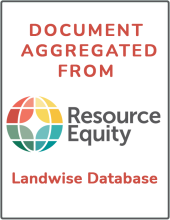Land Library Search
Through our robust search engine, you can search for any item of the over 73,000 highly curated resources in the Land Library.
If you would like to find an overview of what is possible, feel free to peruse the Search Guide.
/ library resources
Showing items 1 through 9 of 110.Damage to crops from wildlife interference is a common threat to food security among rural communities in or near Game Management Areas (GMAs) in Zambia.
Command-and-control policies are often criticized as insufficient to tackle tropical deforestation.
Advanced Hardwood Biofuels Northwest (AHB), a USDA NIFA-funded consortium of university and industry partners, identified southwestern Washington as a potential location for a regional bioproducts industry using poplar trees (Populus spp.) as the feedstock.
Food crises and ecologization have given rise to a Belgian dynamic that does not behave according to the conventional tripod of agroecology: practitioners, social movement, and scientists.
Recent estimates show that one third of the world’s land and water resources are highly or moderately degraded. Global economic losses from land degradation (LD) are as high as USD $10.6 trillion annually.
Landscape fragmentation typical of the Mediterranean region is the result of long-term settlement history and continuous socioeconomic interactions among countries.
Inadequate land management and agricultural activities have largely resulted in land degradation in Burkina Faso.
Overuse of chemical fertilizer has led to severe land degradation and environmental pollution in China. Switching to organic fertilizer may improve soil quality and reduce pollution, which is meaningful to the sustainable development of Chinese agriculture.


